Papers by Renaud Lambiotte
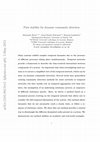
Science Advances
Many systems exhibit complex temporal dynamics due to the presence of different processes taking ... more Many systems exhibit complex temporal dynamics due to the presence of different processes taking place simultaneously. An important task in these systems is to extract a simplified view of their time-dependent network of interactions. Community detection in temporal networks usually relies on aggregation over time windows or consider sequences of different stationary epochs. For dynamics-based methods, attempts to generalize static-network methodologies also face the fundamental difficulty that a stationary state of the dynamics does not always exist. Here, we derive a method based on a dynamical process evolving on the temporal network. Our method allows dynamics that do not reach a steady state and uncovers two sets of communities for a given time interval that accounts for the ordering of edges in forward and backward time. We show that our method provides a natural way to disentangle the different dynamical scales present in a system with synthetic and real-world examples.
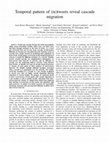
Proceedings of the 2017 IEEE/ACM International Conference on Advances in Social Networks Analysis and Mining 2017, 2017
Twitter has recently become one of the most popular online social networking websites where users... more Twitter has recently become one of the most popular online social networking websites where users can share news and ideas through messages in the form of tweets. As a tweet gets retweeted from user to user, large cascades of information diffusion are formed over the global network. Existing works on cascades have mainly focused on predicting their popularity in terms of size. In this paper, we leverage on the temporal pattern of retweets to model the diffusion dynamics of a cascade. Notably, retweet cascades provide two complementary information: (a) inter-retweet time intervals of retweets, and (b) diffusion of cascade over the underlying follower network. Using datasets from Twitter, we identify two types of cascades based on presence or absence of early peaks in their sequence of inter-retweet intervals. We identify multiple diffusion localities associated with a cascade as it propagates over the network. Our studies reveal the transition of a cascade to a new locality facilitated by pivotal users that are highly cascade dependent following saturation of current locality. We propose an analytical model to show co-occurrence of first peaks with cascade migration to a new locality as well as predict locality saturation from interretweet intervals. Finally, we validate these claims from empirical data showing co-occurrence of first peaks and migration with good accuracy; we obtain even better accuracy for successfully classifying saturated and non-saturated diffusion localities from inter-retweet intervals.
Network Games, Control and Optimization, 2021
We introduce and analyse a three-body consensus model (3CM) for non-linear consensus dynamics on ... more We introduce and analyse a three-body consensus model (3CM) for non-linear consensus dynamics on hypergraphs. Our model incorporates reinforcing group effects, which can cause shifts in the average state of the system even in if the underlying graph is complete (corresponding to a mean-field interaction), a phenomena that may be interpreted as a type of peer pressure. We further demonstrate that for systems with two clustered groups, already a small asymmetry in our dynamics can lead to the opinion of one group becoming clearly dominant. We show that the nonlinearity in the model is the essential ingredient to make such group dynamics appear, and demonstrate how our system can otherwise be written as a linear, pairwise interaction system on a rescaled network.
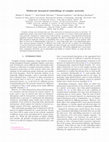
Physical Review E, 2019
Complex systems and relational data are often abstracted as dynamical processes on networks. To u... more Complex systems and relational data are often abstracted as dynamical processes on networks. To understand, predict and control their behavior, a crucial step is to extract reduced descriptions of such networks. Inspired by notions from Control Theory, we propose a time-dependent dynamical similarity measure between nodes, which quantifies the effect a node-input has on the network. This dynamical similarity induces an embedding that can be employed for several analysis tasks. Here we focus on (i) dimensionality reduction, i.e., projecting nodes onto a low dimensional space that captures dynamic similarity at different time scales, and (ii) how to exploit our embeddings to uncover functional modules. We exemplify our ideas through case studies focusing on directed networks without strong connectivity, and signed networks. We further highlight how certain ideas from community detection can be generalized and linked to Control Theory, by using the here developed dynamical perspective.
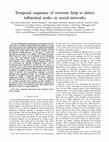
IEEE Transactions on Computational Social Systems, 2019
Identification of influential users in online social networks allows to facilitate efficient info... more Identification of influential users in online social networks allows to facilitate efficient information diffusion to a large part of the network, thus benefiting diverse applications including viral marketing, disease control and news dissemination. Existing methods have mainly relied on the network structure only for the detection of influential users. In this paper, we enrich this approach by proposing a fast, efficient and unsupervised algorithm SmartInf to detect a set of influential users by identifying anchor nodes from temporal sequence of retweets in Twitter cascades. Such anchor nodes provide important signatures of tweet diffusion across multiple diffusion localities and hence act as precursors for detection of influential nodes 1. The set of influential nodes identified by SmartInf have the capacity to expose the tweet to a large and diverse population, when targeted as seeds thereby maximizing the influence spread. Experimental evaluation on empirical datasets from Twitter show the superiority of SmartInf over state-of-the-art baselines in terms of infecting larger population; further, our evaluation shows that SmartInf is scalable to large-scale networks and is robust to missing data. Finally, we investigate the key factors behind the improved performance of SmartInf by testing our algorithm on a synthetic network using synthetic cascades simulated on this network. Our results reveal the effectiveness of SmartInf in identifying a diverse set of influential users that facilitate faster diffusion of tweets to a larger population.
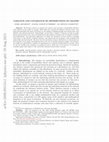
SIAM Review
We develop a theory to measure the variance and covariance of probability distributions defined o... more We develop a theory to measure the variance and covariance of probability distributions defined on the nodes of a graph, which takes into account the distance between nodes. Our approach generalizes the usual (co)variance to the setting of weighted graphs and retains many of its intuitive and desired properties. Interestingly, we find that a number of famous concepts in graph theory and network science can be reinterpreted in this setting as variances and covariances of particular distributions. As a particular application, we define the maximum variance problem on graphs with respect to the effective resistance distance, and characterize the solutions to this problem both numerically and theoretically. We show how the maximum variance distribution is concentrated on the boundary of the graph, and illustrate this in the case of random geometric graphs. Our theoretical results are supported by a number of experiments on a network of mathematical concepts, where we use the variance and covariance as analytical tools to study the (co-)occurrence of concepts in scientific papers with respect to the (network) relations between these concepts.
Journal of Physics: Complexity
This article introduces a new approach to discrete curvature based on the concept of effective re... more This article introduces a new approach to discrete curvature based on the concept of effective resistances. We propose a curvature on the nodes and links of a graph and present the evidence for their interpretation as a curvature. Notably, we find a relation to a number of well-established discrete curvatures (Ollivier, Forman, combinatorial curvature) and show evidence for convergence to continuous curvature in the case of Euclidean random graphs. Being both efficient to approximate and highly amenable to theoretical analysis, these resistance curvatures have the potential to shed new light on the theory of discrete curvature and its many applications in mathematics, network science, data science and physics.
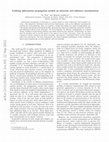
Physical Review E
Information propagation on networks is a central theme in social, behavioral, and economic scienc... more Information propagation on networks is a central theme in social, behavioral, and economic sciences, with important theoretical and practical implications, such as the influence maximization problem for viral marketing. Here, we consider a model that unifies the classical independent cascade models and the linear threshold models, and generalise them by considering continuous variables and allowing feedback in the dynamics. We then formulate its influence maximization as a mixed integer nonlinear programming problem and adopt derivative-free methods. Furthermore, we show that the problem can be exactly solved in the special case of linear dynamics, where the selection criterion is closely related to the Katz centrality, and propose a customized direct search method with local convergence. We then demonstrate the close-to-optimal performance of the customized direct search numerically on both synthetic and real networks.
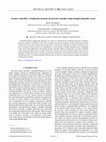
Physical Review E
Centrality measures quantify the importance of a node in a network based on different geometric o... more Centrality measures quantify the importance of a node in a network based on different geometric or diffusive properties, and focus on different scales. Here, we adopt a geometrical viewpoint to define a multiscale centrality in networks. Given a metric distance between the nodes, we measure the centrality of a node by its tendency to be close to geodesics between nodes in its neighborhood, via the concept of triangle inequality excess. Depending on the size of the neighborhood, the resulting Gromov centrality defines the importance of a node at different scales in the graph, and it recovers as limits well-known concepts such as the clustering coefficient and closeness centrality. We argue that Gromov centrality is affected by the geometric and boundary constraints of the network, and illustrate how it can help distinguish different types of nodes in random geometric graphs and empirical transportation networks.
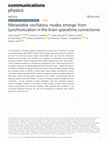
Communications Physics
A rich repertoire of oscillatory signals is detected from human brains with electro- and magnetoe... more A rich repertoire of oscillatory signals is detected from human brains with electro- and magnetoencephalography (EEG/MEG). However, the principles underwriting coherent oscillations and their link with neural activity remain under debate. Here, we revisit the mechanistic hypothesis that transient brain rhythms are a signature of metastable synchronization, occurring at reduced collective frequencies due to delays between brain areas. We consider a system of damped oscillators in the presence of background noise – approximating the short-lived gamma-frequency oscillations generated within neuronal circuits – coupled according to the diffusion weighted tractography between brain areas. Varying the global coupling strength and conduction speed, we identify a critical regime where spatially and spectrally resolved metastable oscillatory modes (MOMs) emerge at sub-gamma frequencies, approximating the MEG power spectra from 89 healthy individuals at rest. Further, we demonstrate that the ...
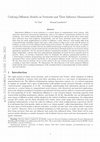
ArXiv, 2021
Information diffusion in social networks is a central theme in computational social sciences, wit... more Information diffusion in social networks is a central theme in computational social sciences, with important theoretical and practical implications, such as the influence maximisation problem for viral marketing. Two widely adopted diffusion models are the independent cascade model where nodes adopt their behaviour from each neighbour independently, and the linear threshold model where collective effort from the whole neighbourhood is needed to influence a node. However, both models suffer from certain drawbacks, including a binary state space, where nodes are either active or not, and the absence of feedback, as nodes can not be influenced after having been activated. To address these issues, we consider a model with continuous variables that has the additional advantage of unifying the two classic models, as the extended independent cascade model and the extended linear threshold model are recovered by setting appropriate parameters. For the associated influence maximisation probl...
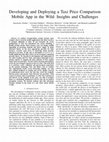
2018 IEEE 5th International Conference on Data Science and Advanced Analytics (DSAA), 2018
As modern transportation systems become more complex, there is need for mobile applications that ... more As modern transportation systems become more complex, there is need for mobile applications that allow travelers to navigate efficiently in cities. In taxi transport the recent proliferation of Uber has introduced new norms including a flexible pricing scheme where journey costs can change rapidly depending on passenger demand and driver supply. To make informed choices on the most appropriate provider for their journeys, travelers need access to knowledge about provider pricing in real time. To this end, we developed OpenStreetCab a mobile application that offers advice on taxi transport comparing provider prices. We describe its development and deployment in two cities, London and New York, and analyse thousands of user journey queries to compare the price patterns of Uber against major local taxi providers. We have observed large heterogeneity across the taxi transport markets in the two cities. This motivated us to perform a price validation and measurement experiment on the ground comparing Uber and Black Cabs in London. The experimental results reveal interesting insights: not only they confirm feedback on pricing and service quality received by professional driver users, but also they reveal the tradeoffs between prices and journey times between taxi providers. With respect to journey times in particular, we show how experienced taxi drivers, in the majority of the cases, are able to navigate faster to a destination compared to drivers who rely on modern navigation systems. We provide evidence that this advantage becomes stronger in the centre of a city where urban density is high.
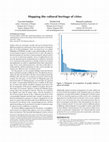
Modern cities are extremely versatile and can be described from different perspectives and datase... more Modern cities are extremely versatile and can be described from different perspectives and datasets, from census data to Foursquare data [1]. In this preliminary work, our main focus is to exploit Wikipedia and Wikidata in order to gain understanding on the spatial and temporal aspects of cultural activity in cities. We adopt an historical perspective and aim at characterising the cultural activity of a city by its cultural personalities. Given a neighbourhood, who were the important poets, mathematicians or architects associated to it? Answering such questions is certainly of interest to tourists and inhabitants, in order to comprehend better their cultural heritage. From a more global perspective, such data would allow to understand the cultural organisation of cities, and its possible segregation into different types of cultural activity. For this purpose, we are currently building a network between places and famous people in different cities. We illustrate the procedure for the...
Physical Review E, 2021
A broad range of dynamical systems involve multi-body interactions, or group interactions, which ... more A broad range of dynamical systems involve multi-body interactions, or group interactions, which may not be encoded in traditional graphical structures. In this work, we focus on a canonical example from opinion dynamics, the Majority Rule, and investigate the possibility to represent and analyse the system by means of hypergraphs. We explore the formation of consensus and restrict our attention to interaction groups of size 3, in order to simplify our analysis from a combinatorial perspective. We propose different types of hypergraph models, incorporating modular structure or degree heterogeneity, and recast the dynamics in terms of Fokker-Planck equations, which allows us to predict the transient dynamics toward consensus. Numerical simulations show a very good agreement between the stochastic dynamics and theoretical predictions for large population sizes.
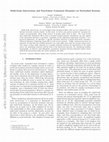
Physical Review E, 2020
Multi-body interactions can reveal higher-order dynamical effects that are not captured by tradit... more Multi-body interactions can reveal higher-order dynamical effects that are not captured by traditional two-body network models. In this work, we derive and analyse models for consensus dynamics on hypergraphs, where nodes interact in groups rather than in pairs. Our work reveals that multi-body dynamical effects that go beyond rescaled pairwise interactions can only appear if the interaction function is non-linear, regardless of the underlying multi-body structure. As a practical application, we introduce a specific non-linear function to model three-body consensus, which incorporates reinforcing group effects such as peer pressure. Unlike consensus processes on networks, we find that the resulting dynamics can cause shifts away from the average system state. The nature of these shifts depends on a complex interplay between the distribution of the initial states, the underlying structure and the form of the interaction function. By considering modular hypergraphs, we discover state-dependent, asymmetric dynamics between polarised clusters where multi-body interactions make one cluster dominate the other.
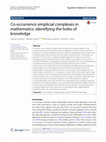
Applied Network Science, 2018
In the last years complex networks tools contributed to provide insights on the structure of rese... more In the last years complex networks tools contributed to provide insights on the structure of research, through the study of collaboration, citation and co-occurrence networks. The network approach focuses on pairwise relationships, often compressing multidimensional data structures and inevitably losing information. In this paper we propose for the first time a simplicial complex approach to word co-occurrences, providing a natural framework for the study of higher-order relations in the space of scientific knowledge. Using topological methods we explore the conceptual landscape of mathematical research, focusing on homological holes, regions with low connectivity in the simplicial structure. We find that homological holes are ubiquitous, which suggests that they capture some essential feature of research practice in mathematics. k-dimensional holes die when every concept in the hole appears in an article together with other k + 1 concepts in the hole, hence their death may be a sign of the creation of new knowledge, as we show with some examples. We find a positive relation between the size of a hole and the time it takes to be closed: larger holes may represent potential for important advances in the field because they separate conceptually distant areas. We provide further description of the conceptual space by looking for the simplicial analogs of stars and explore the likelihood of edges in a star to be also part of a homological cycle. We also show that authors' conceptual entropy is positively related with their contribution to homological holes, suggesting that polymaths tend to be on the frontier of research.
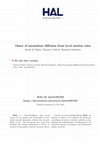
Physical Review E, 2017
Anomalous diffusion processes, in particular superdiffusive ones, are known to be efficient strat... more Anomalous diffusion processes, in particular superdiffusive ones, are known to be efficient strategies for searching and navigation by animals and also in human mobility. One way to create such regimes are Lévy flights, where the walkers are allowed to perform jumps, the "flights", that can eventually be very long as their length distribution is asymptotically power-law distributed. In our work, we present a model in which walkers are allowed to perform, on a 1D lattice, "cascades" of n unitary steps instead of one jump of a randomly generated length, as in the Lévy case, where n is drawn from a cascade distribution pn. We show that this local mechanism may give rise to superdiffusion or normal diffusion when pn is distributed as a power law. We also introduce waiting times that are power-law distributed as well and therefore the probability distribution scaling is steered by the two PDF's power-law exponents. As a perspective, our approach may engender a possible generalization of anomalous diffusion in context where distances are difficult to define, as in the case of complex networks, and also provide an interesting model for diffusion in temporal networks.
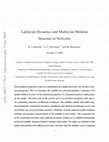
arXiv: Physics and Society, Dec 9, 2008
Most methods proposed to uncover communities in complex networks rely on their structural propert... more Most methods proposed to uncover communities in complex networks rely on their structural properties. Here we introduce the stability of a network partition, a measure of its quality defined in terms of the statistical properties of a dynamical process taking place on the graph. The timescale of the process acts as an intrinsic parameter that uncovers community structures at different resolutions. The stability extends and unifies standard notions for community detection: modularity and spectral partitioning can be seen as limiting cases of our dynamic measure. Similarly, recently proposed multi-resolution methods correspond to linearisations of the stability at short times. The connection between community detection and Laplacian dynamics enables us to establish dynamically motivated stability measures linked to distinct null models. We apply our method to find multi-scale partitions for different networks and show that the stability can be computed
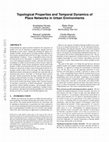
Proceedings of the 24th International Conference on World Wide Web, 2015
Understanding the spatial networks formed by the trajectories of mobile users can be beneficial t... more Understanding the spatial networks formed by the trajectories of mobile users can be beneficial to applications ranging from epidemiology to local search. Despite the potential for impact in a number of fields, several aspects of human mobility networks remain largely unexplored due to the lack of large-scale data at a fine spatiotemporal resolution. Using a longitudinal dataset from the location-based service Foursquare, we perform an empirical analysis of the topological properties of place networks and note their resemblance to online social networks in terms of heavy-tailed degree distributions, triadic closure mechanisms and the small world property. Unlike social networks however, place networks present a mixture of connectivity trends in terms of assortativity that are surprisingly similar to those of the web graph. We take advantage of additional semantic information to interpret how nodes that take on functional roles such as 'travel hub', or 'food spot' behave in these networks. Finally, motivated by the large volume of new links appearing in place networks over time, we formulate the classic link prediction problem in this new domain. We propose a novel variant of gravity models that brings together three essential elements of inter-place connectivity in urban environments: network-level interactions, human mobility dynamics, and geographic distance. We evaluate this model and find it outperforms a number of baseline predictors and supervised learning algorithms on a task of predicting new links in a sample of one hundred popular cities.
IFAC-PapersOnLine, 2015
Epidemic process on networks is considered. The system is discribed as a metapopulation network i... more Epidemic process on networks is considered. The system is discribed as a metapopulation network in which a node represents subpopulation (e.g., city or school) and is connected to other nodes via undirected links. Particles represent the subject of infection (e.g., individuals) and interact with each other within nodes while migrating from nodes to nodes in the manner of random diffusion. The nonlinear dependence of contact rate within a node on its population size is introduced, according to the recent finding based on emprical phone-call data. The impacts of the nonlinear dependence are investigated for three aspects of epidemic process: epidemic threshold, infection size at stationary state, and transient dynamics.

Uploads
Papers by Renaud Lambiotte